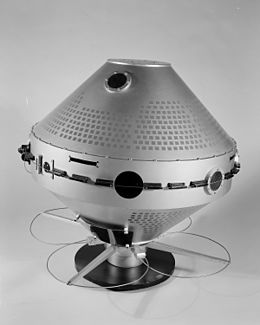Explorer 8
 Explorer 8 | |
| Mission type | Earth science |
|---|---|
| Operator | NASA |
| Harvard designation | 1960 Xi 1 |
| COSPAR ID | 1960-014A |
| SATCAT no. | 00060 |
| Mission duration | 54 days |
| Spacecraft properties | |
| Manufacturer | Jet Propulsion Laboratory |
| Launch mass | 40.88 kilograms (90.1 lb) |
| Power | 100.0 watts |
| Start of mission | |
| Launch date | November 3, 1960, 05:23:10 UTC |
| Rocket | Juno II AM-19D |
| Launch site | Cape Canaveral LC-26B |
| End of mission | |
| Last contact | December 27, 1960 |
| Decay date | March 28, 2012 |
| Orbital parameters | |
| Reference system | Geocentric |
| Regime | Medium Earth |
| Semi-major axis | 7,722.00 kilometers (4,798.23 mi) |
| Eccentricity | 0.12108247 |
| Perigee altitude | 416 kilometers (258 mi) |
| Apogee altitude | 2,286 kilometers (1,420 mi) |
| Inclination | 49.9 degrees |
| Period | 112.7 minutes |
| Epoch | 5 December 1960[1] |
Explorer 8 was an American research satellite launched on November 3, 1960.[2] It was intended to study the temporal and spatial distribution of the electron density, the electron temperature, the ion concentration, the ion mass, the micrometeorite distribution, and the micrometeorite mass in the ionosphere at altitudes between 400 and 1600 km and their variation from full sunlit conditions to full shadow, or nighttime, conditions.
The payload was in the form of two truncated cones with the bases attached to a cylindrical equator. The outer shell was aluminum and had a diameter of 76 cm and a height of 76 cm. The 108.00 MHz transmitter had 100 mW average power, and it functioned for the life of the battery pack (54 days). The data system included telemetry consisting of continuous operation with real-time transmission.
To avoid the possibility of effects on the experiments by asymmetrical charging on solar cell surfaces, solar cells were not used.
Experiment instrumentation included an RF impedance probe, an ion current monitor, a retarding potential probe, a two-element and a three-element electron temperature probe, an electron current monitor, a photomultiplier-type and a microphone-type micrometeorite detector, an electric field meter, a solar horizon sensor, and thermistor temperature probes. Simultaneous measurements of electron and ion concentration were used to resolve the question of neutrality of the medium.
Battery power failed on December 27, 1960. Considerable difficulty was encountered with decommutating the telemetered data to make machine processing possible. As a result of these difficulties, the data were mostly processed by hand. In spite of these difficulties, considerable new knowledge about the ionosphere was gained from operation of the satellite.[3] Explorer 8 decayed from orbit on 28 March 2012.
A replica is on display at the Smithsonian National Air and Space Museum's Steven F. Udvar-Hazy Center in Chantilly, Virginia.[4]

References
- ^ McDowell, Jonathan. "Satellite Catalog". Jonathan's Space Page. Retrieved December 17, 2013.
- ^ "Explorers: Searching the Universe Forty Years Later". NASA Fact Sheets. Goddard Space Flight Center, NASA. Archived from the original on May 11, 2008. Retrieved February 3, 2008.
- ^ "Explorer 8". NASA Space Science Data Coordinated Archive. NASA. Retrieved June 29, 2016.
- ^ "Explorer 8 satellite". Smithsonian National Air and Space Museum. Smithsonian Institution. Archived from the original on July 4, 2012.

